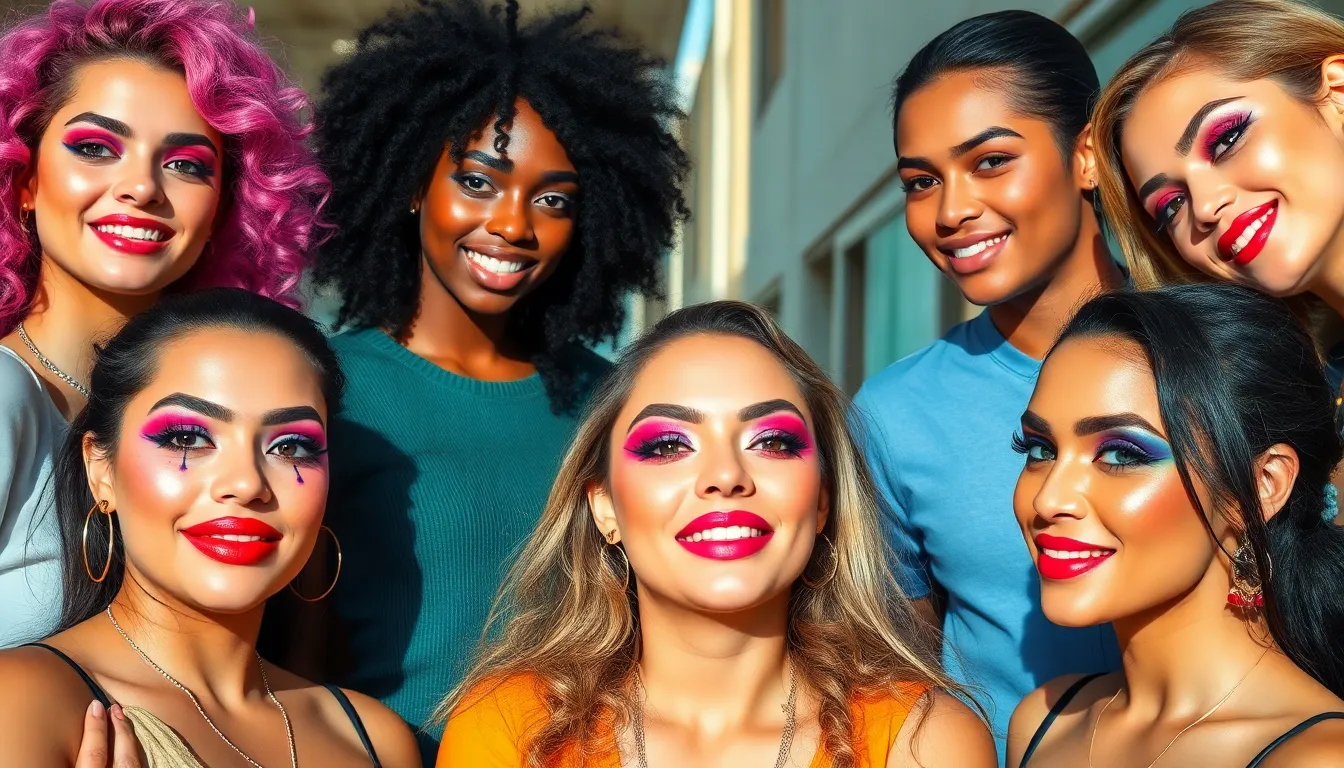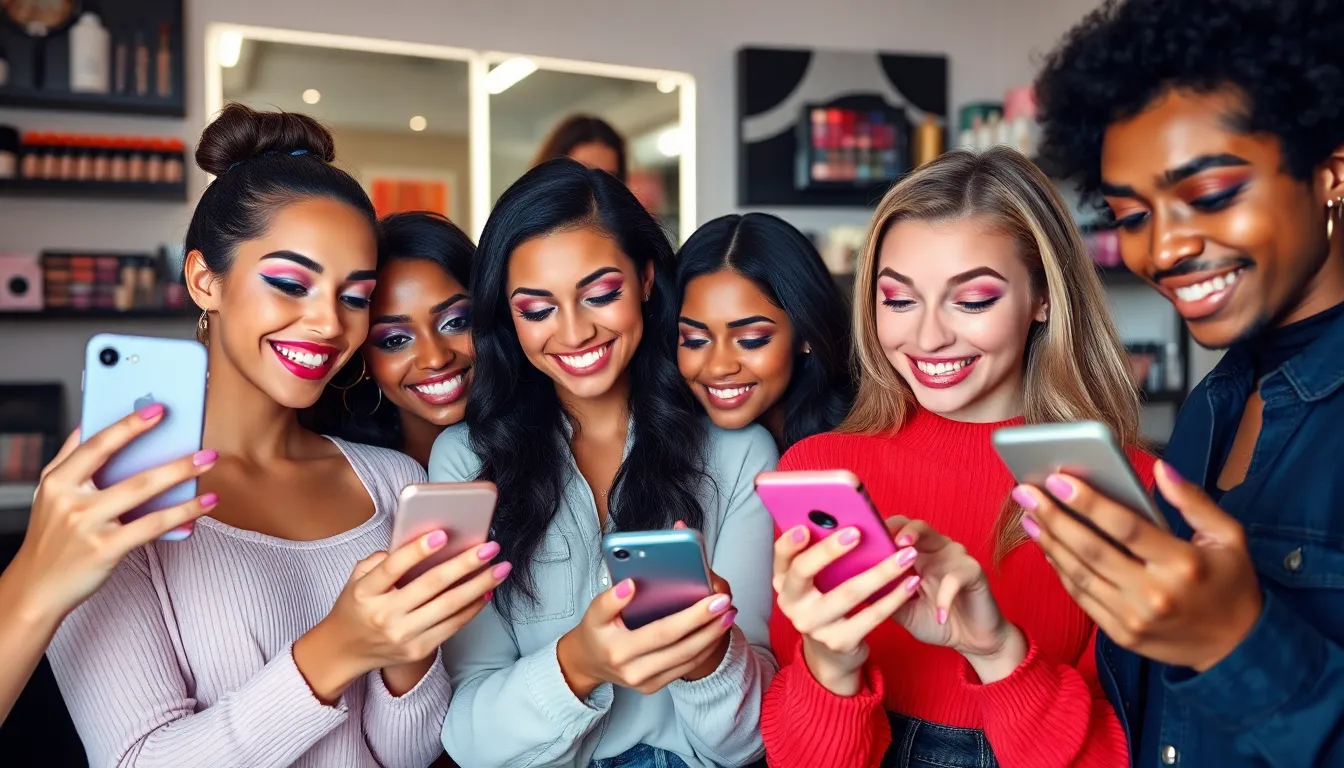In a world where filters reign supreme and beauty standards shift faster than a TikTok dance trend, social media has become the ultimate playground for beauty enthusiasts. From the viral “glass skin” craze to the bold resurgence of 90s makeup, platforms like Instagram and TikTok are shaping how people perceive and express beauty. It’s not just about looking good anymore; it’s about looking good while doing the latest viral challenge.
With influencers leading the charge, beauty trends can go from zero to viral in a matter of hours. But what truly drives these trends? Is it creativity, a sprinkle of chaos, or just the latest must-have product? Dive into the fascinating world of social media beauty trends, where every scroll could introduce the next big thing—or at least a new way to apply highlighter that’ll make you shine brighter than your future.
Social Media Beauty Trends
Social media platforms play a pivotal role in shaping contemporary beauty trends. Instagram and TikTok serve as key influencers, amplifying the visibility of trends like “glass skin” and the resurgence of 90s makeup styles. Viral challenges on these platforms create massive engagement among beauty enthusiasts, driving participants to try new looks.
Users quick to embrace these trends often share tutorials and tips, fostering a community of learning and creativity. Innovative makeup techniques gain traction rapidly, often leading to widespread adoption and reinterpretation. Trends typically reflect the digital generation’s desire for self-expression and authenticity, making beauty more accessible to diverse audiences.
Statistics indicate that over 70% of beauty consumers discover products via social media. Engagement on platforms leads to real-world sales, transforming online popularity into market demand. Emerging trends frequently arise from user-generated content, highlighting the power of influencers and everyday users alike.
Adaptation becomes essential as beauty standards continue to evolve. Previous standards fade, making way for fresh aesthetics influenced by cultural events and movements. Environments where beauty norms shift create opportunities for new brands to emerge, capturing the attention of trendsetters.
Ultimately, social media influences shape beauty by breaking down barriers and inviting creativity. The constant flow of content ensures that trends remain dynamic, with each new posting shaping perceptions and preferences in the beauty world.
Popular Platforms for Beauty Trends


Social media platforms significantly influence beauty trends today. Instagram and TikTok lead the way in shaping what consumers perceive as desirable and innovative.
Instagram serves as a visual playground for beauty trends. Influencers showcase makeup looks through high-quality images and video content. The platform allows users to explore tutorials with hashtags like #MakeupTutorial or #BeautyHacks. Brands often release products in collaboration with popular influencers, ensuring wider reach and engagement. Users frequently discover emerging trends like “glass skin” or bold makeup styles through their feeds. Engagement statistics reveal that 80% of users follow at least one beauty brand. This high level of involvement drives sales and encourages experimentation among users.
TikTok
TikTok rapidly became a hub for viral beauty challenges. Content creators spark interest with short, engaging videos featuring innovative techniques and transformations. Users often jump on trends like the “90s makeup revival” or “euphoria-inspired looks.” TikTok’s algorithm fosters virality, allowing users to discover products and techniques quickly. Data indicates that beauty-related videos receive over 13 billion views on the platform. Each tutorial inspires others to try their hand at trending looks. Additionally, challenges promote community interaction, leading to shared experiences and collective engagement within the beauty community.
Influencers Shaping Beauty Trends
Social media influencers play a crucial role in defining modern beauty trends. They connect brands with consumers, igniting interest and encouraging experimentation.
Micro-Influencers
Micro-influencers, those with followers ranging from 1,000 to 100,000, significantly shape beauty trends. They often create niche content, resonating with specific audiences who value their authenticity. Engagement rates for micro-influencers are generally higher, leading to more genuine connections with their followers. Brands frequently collaborate with these influencers, recognizing their ability to inspire trust and motivate purchasing decisions. Due to their relatable persona, micro-influencers often introduce innovative products and techniques, sparking viral challenges that captivate beauty enthusiasts. With their focused reach, micro-influencers drive conversations within niche beauty communities, making them integral to trend formation.
Celebrity Influencers
Celebrity influencers wield considerable power in the beauty industry. Their vast follower counts enable them to reach a broad audience, making their endorsements highly impactful. Often, they launch their own beauty lines, leveraging their fame to create immediate interest. High-profile collaborations with established brands further amplify their influence, driving trends that often become mainstream. Followers admire celebrity influencers for their glamorous lifestyles and diverse makeup looks. They regularly set trends with high-fashion displays and skincare routines, significantly impacting consumer behavior. Celebrity-driven campaigns can result in immediate sales spikes, reflecting their ability to create demand within the beauty market.
Trending Beauty Challenges
Social media continuously fosters innovative beauty challenges that capture the attention of enthusiasts worldwide. Participants engage in these trends, showcasing creativity and adaptability.
Viral Makeup Looks
Viral makeup looks often dominate social media feeds, with platforms like TikTok setting the stage for remarkable transformations. Participants recreate iconic styles, such as the grunge aesthetic or bold graphic eyeliner, gaining widespread popularity. Creators often attach specific hashtags, making it easier for users to find and replicate these visually striking concepts. The rapid sharing of tutorials enhances accessibility, allowing newcomers to master techniques with ease. Captivating transformations attract millions of views, particularly when influencers showcase unique spins on established trends.
Skincare Routines
Skincare routines often trend alongside makeup challenges, with beauty enthusiasts meticulously documenting their processes. Followers eagerly adopt multi-step routines, frequently embracing the K-beauty influence that emphasizes hydration and glow. Popular ingredients like hyaluronic acid and niacinamide take center stage, sparking discussions about efficacy and benefits. Community members actively share their experiences, collectively striving for radiant skin. Engaging videos emphasize each step, transforming daily rituals into shared experiences that educate and inspire. Consequently, social media users prioritize self-care, leading to an increased awareness of skincare’s crucial role in overall beauty practices.
The Impact of Social Media on Beauty Standards
Social media platforms significantly shape contemporary beauty standards. Over 70% of beauty consumers discover products via these platforms, highlighting their influence. Instagram functions as a visual hub where beauty influencers share high-quality images and videos of makeup looks. Users engage with tutorials by exploring popular hashtags, fostering a sense of community among beauty enthusiasts.
TikTok has emerged as a critical player in the beauty landscape, offering viral challenges that capture user attention. Over 13 billion views on beauty-related videos demonstrate the platform’s reach and ability to promote trends. Participants eagerly recreate makeup looks, showcasing their creativity through short, engaging clips. Challenges focusing on skincare routines align with makeup trends, introducing multi-step processes influenced by K-beauty principles.
Influencers play a pivotal role in defining beauty trends. Micro-influencers, who typically have between 1,000 and 100,000 followers, create content that resonates with niche audiences. Their authenticity fosters genuine connections and drives discussions within beauty communities. Celebrity influencers, with their extensive follower counts, reach broader audiences by launching beauty lines and collaborating with established brands.
The impact of social media extends to immediate changes in consumer behavior. Glamorous lifestyles showcased by influencers often lead to sales spikes for newly introduced products. Engaging beauty challenges not only invite participation but also encourage experimentation with makeup styles and skincare routines, reflecting the diverse interests of today’s digital generation.
Ultimately, social media democratizes beauty, promoting self-expression and adaptability while reflecting the evolving standards of attractiveness in the digital age.
Conclusion
The influence of social media on beauty trends is undeniable. As platforms evolve so do the standards of beauty and self-expression. The rise of micro-influencers and engaging viral challenges fosters a sense of community and creativity among beauty enthusiasts.
This ever-changing landscape encourages experimentation and authenticity, allowing individuals to explore their unique styles. With each scroll through Instagram or TikTok, new trends emerge and redefine what beauty means in today’s digital age. The future of beauty will continue to be shaped by these platforms, reflecting the diverse voices and innovative ideas of the global community.
